I’ve just returned from my first vacation in China. I came to the realization earlier this year that despite routine visits to China, I had only seen one tiny part of China — mostly the insides of factories in Guandong province. I’ve heard that China is much bigger than that, and so Chuang Tzu’s little frog decided it was time to poke its head above the well and see how big the sky is. My perlfriend and I picked a couple spots far, far away from factories. I wanted to go to Harbin, but we couldn’t find convenient flights, so instead we went to Yangshuo and Chongqing. Chances are you’ve never heard of them — and that’s exactly why we decided to visit them.
Yangshuo and its peasants tending rice paddies was an interesting study on China’s past; Chongqing was an interesting study on China’s future. According to wikipedia, the municipality of Chongqing has a population of 28 million people (that’s more than the entirety of Australia), yet few of my western friends have heard of it. It’s a special administrative zone, directly managed by Beijing; non-ironic pictures and busts of chairman Mao were common fixtures. This is in contrast to Shenzhen’s western influences, in part due to its proximity to Hong Kong. Chongqing is a hotbed of investment and growth; I’ve heard the city mentioned numerous times in rumors of mass factory migrations from Guandong to central China, where costs are lower. The city of Chongqing is definitely a lot cheaper than Shenzhen, even for a tourist; everything from cabs to food to hotel was cheaper by a substantial margin. While the air quality was terrible in Chongqing, overall I had to say I was pleasantly surprised to find that the citizens of Chongqing had a remarkably … wholesome … feel about them. They felt more laid back than Shenzheners. Kids played in the street. Teens would congregate at night in the plaza near my hotel and hang out, but were well behaved even into the wee hours. One could hardly walk a block without seeing people playing Mahjong in the street on makeshift card tables. My interactions with shop vendors were friendly, and often pleasant; bargaining was easier, and the service was generally patient and helpful. I suppose part of this might be due to the fact that a foreigner is still a novelty in Chongqing; in two days I saw only two western-looking people, and few spoke English. It probably also helps that Chongqing’s population is more local, with fewer seasonal workers and estranged immigrants.
I normally don’t make fun of Engrish — partially because there’s so much Engrish in China it’s hard to know where to start, and partially because my Budong Hua (get it? 普通话 (putong hua) = “Mandarin” vs. 不懂话 (budong hua) = “not understanding language”…the Mandarin equivalent of “Engrish”) is so bad I’m throwing stones from a glass house. However, this one item from a menu at a hotpot place called “qi huo guo” (chongqing is supposedly the origin of hotpot) really caught my inner nerd’s eye.
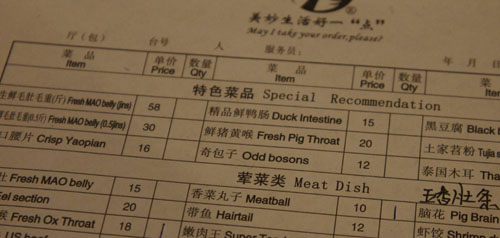
Given a choice between pig brains, ox throat or “odd bosons” (奇包子), I’d be most concerned about ingesting food made from strange fundamental particles; at least the others aren’t potentially made of antimatter. Thankfully, the odd bosons aren’t a product of some LHC experiment gone awry. “Odd bosons” are simply the restaurant’s eponymous dumplings (qi huo guo means “odd hot pot”). On recommendation by the waitstaff, I ordered the odd bosons. They were delicious.
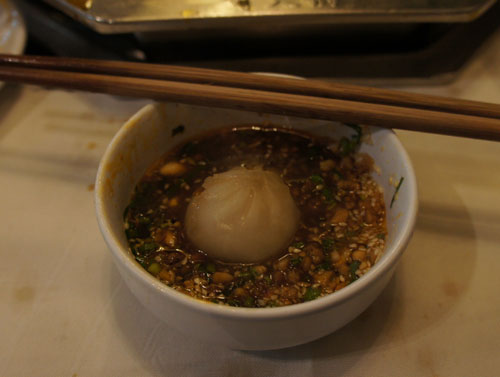
On my way back to Singapore, I stopped through Shenzhen and gave Star Simpson an introductory tour of the hua qian bei markets. While wandering I finally found a book I had long been searching for:
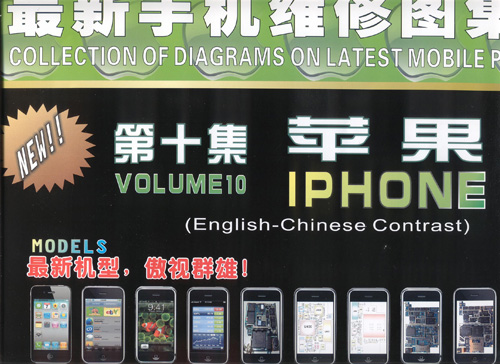
Yep, that’s right, the book of iPhone schematics. I snapped that baby up for $4. Unfortunately, the pages are bigger than my flatbed scanner, so I could only capture about 80% of a page. Here’s a snippet from the table of contents:
Inside are a few handy diagrams, such as a component layout guide:
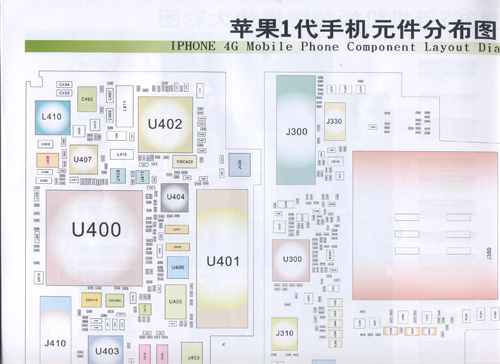
And also a list of key footprints with interesting pins highlighted:
And of course, pages and pages of schematics:
My feeling is that these schematics probably come from leaks of original Apple sources, because many of the annotations couldn’t be divined from a clean-room reverse engineering job. For example, the above schematics annotate that the AP_UART connection on the dock has a dual-footprint option for a possible drop-in DisplayPort upgrade. Anyways, these schematics are useful as a sourcing guide for cheap components. Any part found in this book has been made in millions-per-week quantities, which is a handy fact to keep in mind when bargain hunting for stable supplies of cheap components.
A classy addition to this book is a full-color teardown guide, with photos courtesy of ifixit:
While the book doesn’t credit ifixit for their labors, there are few things more validating of ifixit’s world-class status than Shanzhai copying ifixit’s materials into the canon of phone repair guides. Mad props to my peeps at ifixit.
Another little gem I bought in the market are the metal stencils pictured below.
These stencils, purchased at less than $1 each, are for various mobile phone chipsets. The stencils come in this “summary” form, and also in a more useful knock-out library where the metal is pre-cut around the edges of the footprints so you can clip out a single footprint and use it to guide the application of solderpaste to a PCB. However, my suspicion is that these “summary” form stencils are probably not used for applying solderpaste to mainboards, but rather used to identify chips that have been pulled off of boards through mass desoldering, and also for use in reballing the same BGAs. I’ve seen similar stencils used with great efficacy to manually reball BGAs on a factory line in Guanzhou. Hand-reballing of BGAs is surprisingly fast and efficient with the aid of a stencil and a machined jig. I remember watching with prurient fascination as the operator reballed BGA after BGA in a matter of minutes; mental arithmetic placed the cost of reballing at around a dime. Thus refurbished, the recycled chips can be used to repair broken phones, or to build whole “new” phones from scratch.

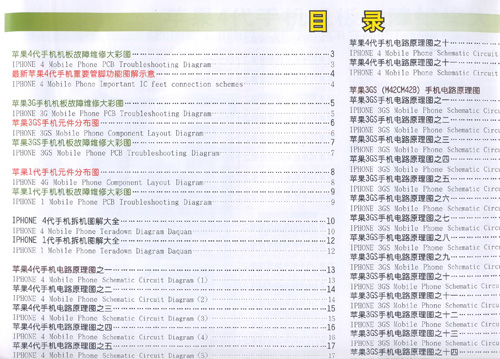
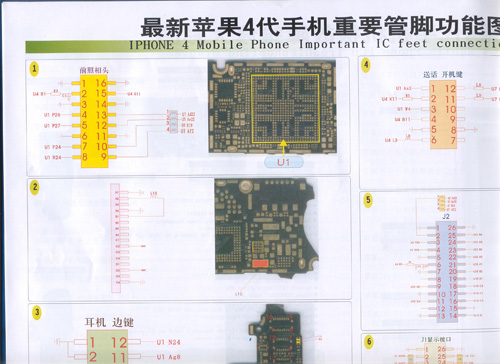
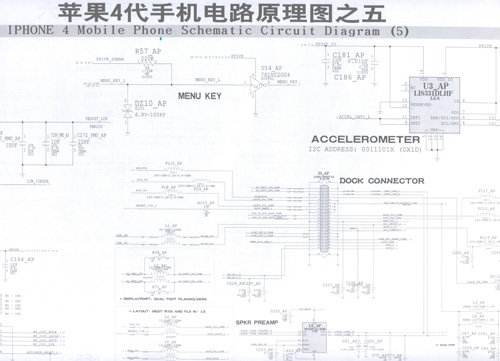
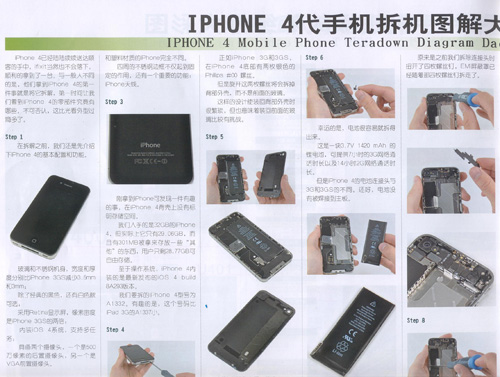
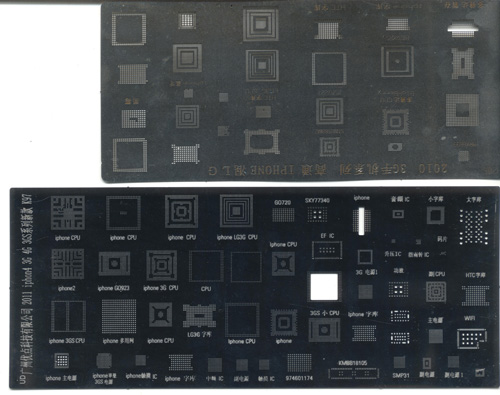
Tjos blog entry is just bursting with fascinating titbits -thanks for writing about your experiences! Any chance of a follow up focusing on Yangzhou?
Looks like a first real confirmation that Apple has dumped the Line In on the dock connector.
I’d really like to see the entire iPhone schematics. Any online source for the book? Or would you try to fully scan them?
[…] Random Stories from China @ bunnie’s blog. Yep, that’s right, the book of iPhone schematics. I snapped that baby up for $4. My feeling is that these schematics probably come from leaks of original Apple sources, because many of the annotations couldn’t be divined from a clean-room reverse engineering job. For example, the above schematics annotate that the AP_UART connection on the dock has a dual-footprint option for a possible drop-in DisplayPort upgrade. Anyways, these schematics are useful as a sourcing guide for cheap components. Any part found in this book has been made in millions-per-week quantities, which is a handy fact to keep in mind when bargain hunting for stable supplies of cheap components. Filed under: random — by adafruit, posted November 15, 2011 at 10:03 am Comments (0) […]
Bunnie, another great blog entry!
I love trying to find my way around hua qian bei markets, but I’ve been unable to find books like that!
Most of the time, I end up on the ground floors of the SEG Market, and the Cellphone Market nearby. (Caps, Resistors, Enough LED’s to burn out my cornea…)
Are there any other real treats in the Hua Qian Bei area that I’ve missed the dozen times I’ve been to Shenzhen? (And please don’t suggest LoHu market! hehehe)
Cheers
Rochey
Rochey, you can see unimaginable things happening to mobile phones here:
http://maps.google.com.hk/?ll=22.540261,114.090604&z=19
I think this is the market you’re marking out on the map:
http://www.bunniestudios.com/blog/?p=287
Basically diagonal to the SEG plaza? That’s the place where I got these schematics. You kinda have to be a bit persistent to find ’em, they are typically tucked away in the corners of certain stalls. They have similar books for Blackberrys, Nokias, Motos, Sony Ericsson, etc. etc.
釣魚島問題專家、香港中文大學亞太研究所研究員鄭海麟從釣魚台列嶼的歷史地位切入,直指釣魚島隸屬中國毫無疑義。他指出,中日兩國大量歷史文獻表明,最早發現、命名和使用釣魚台列嶼的是中國人,而不是琉球人或日本人。釣魚島列嶼並不屬於「舊琉球王朝的勢力所及範圍」,該列嶼在明朝便被納入中國海防及行政管制區域。
一九五一年的《舊金山(三藩市)合約》根本沒有涉及釣魚台列嶼的主權問題。一九五二年美國託管當局將釣魚島列嶼劃入琉球列島地理境界的經緯度內,是極不適當和不合國際法的。因此,日本聲稱擁有該列嶼主權在國際法上不能成立。
中國大陸學者近年來對釣魚島議題的研究下了很大工夫。清華大學當代國際關係研究院副院長劉江永教授指出,事實證明日本早在甲午戰爭前十年已知釣魚台列嶼屬於中國。
日外務省當年編撰的《日本外交文書》第十八卷和第二十三卷中,對明治政府竊取釣魚島的決策過程有非常詳實的記載。換言之,釣魚台列嶼是日本乘甲午戰爭之機,未等簽署馬關條約而從中國竊取的。如今,日方稱其與馬關條約,即甲午戰爭無關,根本站不住腳。
二戰後釣魚島問題懸而未決與美國介入密不可分。劉江永指出,一九七一年美國擅自決定將釣魚島的行政管轄權交給日本政府,遭到全球華人的強烈反對,掀起保釣浪潮,迫使美國迄今迄未承認日本擁有釣魚島的主權,而希望中日雙方和平協商解決。
然而,二零一零年以來美國政府多次明確表示,釣魚島適用於美日安保條約第五條,「這是造成日本政府在釣魚島問題上有恃無恐採取強硬做法的重要外部因素」。
事實上,東京法院曾經判定釣魚島屬於台北州。台灣光復前一年,台灣與琉球為釣魚島發生歸屬權之爭,當時該法院將釣魚台列嶼判決為台北州所有,更加證明釣魚島主權屬台灣。
此外,中國大陸學者、上海社會科學研究院法學研究所副研究員、海洋法研究中心主任金永明,上海國際問題研究院學術委員會副主任、上海市日本學會會長吳寄南等,也發表論文,探索釣魚島的國際地位,力證釣魚島主權屬中華民族。
台灣師範大學東亞系助理教授林賢參則從戰略意涵分析釣魚島問題的本質。他說,中國大陸追求成為「海洋強國」,企圖掌控西太平洋海域之制海權,會壓縮日本防衛之戰略縱深;政治大學亞太研究所副研究員李瓊莉,也提出國際經驗的比較。
政大外交系教授趙國材說,釣魚台列嶼問題迄今無解,指出釣魚島問題不論從歷史地位或法律地位探討皆無意義,因為國際政治乃強權政治,關於釣魚島主權誰屬是老大哥美國說了算。
趙國材又表示,台灣願意依聯合國憲章及國際法和平解決國際爭端的規範,從主權、戰略位置、海洋權益與維護資源等面向,以確保釣魚台列嶼領土主權完整,與日本談判,並保護台灣漁民權益。唯日方無意願與台灣談判主權問題,只願和台灣談判漁權,想透過台灣獲得漁權用來騙取釣魚台列嶼的主權。但保釣出身的總統馬英九並未上當,既要漁權也要主權。
台灣有人主張拉攏美國介入東海爭端,使日本、中國大陸、台灣、美國形成四方機制,能更有效解決釣魚台列嶼主權問題,並提升台灣之國際地位。趙國材認為,這種做法可能會引狼入室,不見得對台灣有利,因為美日在外交上皆承認北京,與台灣沒有邦交,且釣魚台列嶼附近之海域處於防衛美國本土的第一島鏈上,可能牽動東北亞安全情勢和美日的戰略布局,美國在釣魚台列嶼問題上一向表態中立,骨子裏其實偏袒日本。
台灣政治大學國際法學研究中心研究員邵漢儀首次全部全文公開日方釣魚島的新史料,掀起高潮。邵的父親邵玉銘當年留美時亦曾參與保釣運動,如今父子兩代同台參與釣魚島會議,傳為佳話。
日本外務省於一九七一年提出的《我國關於尖閣諸島領有權的基本見解》聲稱﹕「自一八八五年以來,日本政府通過沖繩縣當局等途徑再三在尖閣諸島進行實地調查,慎重確認尖閣諸島不僅為無人島,而且沒有受清朝統治的痕跡。在此基礎上,於一八九五年一月二十一日,在內閣會議上決定在島上建立標樁,以正式列入我國領土之內。」
為了調查日方說法的真相,邵漢儀曾親往日本查閱相關原件,包括仍未公開的明治時期史料。他從日本外務省外交史料館、防衛省防衛研究所圖書館,以及國立公文書館尋得近四十件原件,首次全部公開。他歷時兩年餘發現明治政府從未派員至釣魚島進行實地調查,所謂「再三」調查純屬捏造。
韓國外國語大學教授黃載皓認為,今年三月中國發表國防白皮書,確立戰略目標是國家現代化、力主防禦性國防、與他國建立軍事互信,他懷疑中日會爆發大戰,也不認為日本會放棄二戰後的現代化貿然掀起戰端。不過,另一位韓國學者國家安保戰略研究院研究員朴炳光指出,韓日兩國近年提出擴大交流合作關係的「新時代」理念,但對於韓國,獨島攸關經濟及軍事戰略國家利益,不可能讓步。
bunnie, awesome blog entry! More please! ;) If Chumby ever stops, you could easily work as the world’s coolest hacker-travel blogger.
Hi,
I wonder if we could use iphone cameras for robotics, as they are cheap and high resolution. Any chance of getting scans of this book?
Very interesting entry. I would like to go to China in holidays someday.
Also very interesting the iphone 4 schematics. Using the data in the image you show, I have found several iphone pdf schematics in the wild. The links are in my blog:
http://insidetronics.blogspot.com/2011/11/iphone-4-schematics.html
I love to see other engineers designs and learn from them…
What is the date of your schematics, bunnie? The last one I have found is from Apr 2010 and is called: N90 SINGLE_BOARD PVT.
Cheers,
mangel
The schematics in the book are from the 2009 prototype schematics (I checked a few spots and the annotations more closely match the 2009 schematics). The Apr 2010 one you found are more recent than the ones in the book.
Interestingly, my copy of the schematics have been digested in a vector editing tool and reformatted by pasting bits ad pieces together so they fill the large pages of the book more effectively. So someone spent some effort curating the schematics before doing a print run. It also explains the occasional Engrish in the schematics.
Thanks for searching for these and sharing them! I did a quick google search myself and got the sense that they are out there, but I didn’t spend the time to find valid links. This should satisfy the requests for scans of the book.
Did you mean http://en.wikipedia.org/wiki/Huaqiangbei ? It’s actually hua-qiang-bei, with a G :-)
You’re right, thanks for correcting me! My pinyin needs work:-)
bunnie, this was the most fascinating thing I’ve read in a long time. Thanks for writing it!
And I agree with what was said above – you’d be awesome as a full time hacker/travel blogger.
(Is it weird that since meeting you so long ago, I always see you as Hiro Protagonist in my head when I read Snowcrash?)
I guess if I ever visit China (which I want to do some day) I will need to be a bit flexible with my meals…
I guess a bit of intestine and throat might be a tasty break from chicken and beef?
[…] Huang of Chumby writes about buying an iPhone schematic on the street in Shenzhen and using it to source cheap parts. Chris calls this […]
[…] schematics and more… – [Link] Tags: iPhone, schematics Filed in Uncategorized | 2 views No Comments […]
[…] […]
[…] somebody the full of this book: Random Stories from China « bunnie's blog or this picture: http://img689.imageshack.us/img689/6…4usbdriver.jpg It’s very […]
[…] somebody the full of this book: Random Stories from China « bunnie's blog or this picture: http://img689.imageshack.us/img689/6…4usbdriver.jpg It’s very […]
[…] somebody the full of this book: Random Stories from China « bunnie's blog or this picture: http://img689.imageshack.us/img689/6…4usbdriver.jpg It’s very […]
[…] Other times they just tear down a product and replicate everything internally and externally (see also: China). Most of the time though, the company will try to replicate the behavior and not necessarily copy […]
[…] While in the SEG market, you can even buy an iPhone schematic! […]
you hear is “qi huo guo” Actually he said is “chi huoguo” ( 吃火锅 )
in china there is many translation errors .
[…] problem is not lack of recycling, or e-waste—it’s mining and manufacturing”), a Chinese repair manual that cribbed photos from iFixit.com (“Please, take our manual and use it to fix […]